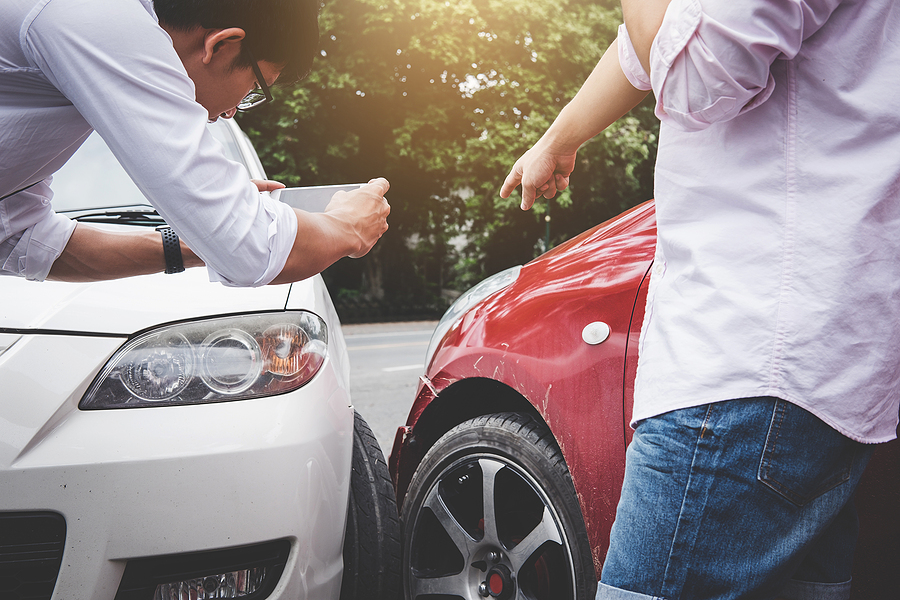
Determining fault for a car crash may seem simple at first. Unfortunately, even obviously negligent drivers and their insurers may attempt to shift some or all of the blame onto the drivers injured in the accident. You may suddenly find yourself questioned about your speed, driving history, and vehicle maintenance practices. What seemed like an open and closed case could result in months of back-and-forth communications with the at-fault driver’s insurance company, delaying your ability to pay medical bills, cover lost wages, and repair your car.
Even when insurers unjustly split liability to close a claim, these decisions only apply to insurance payouts. You might still invoke your right to challenge liability in court and demand fair compensation after a motor vehicle collision. A local car accident attorney can help you review the facts of your case and explain how your state determines fault and apportions car accident liability.
Defining Fault in Car Accident Cases
As the term suggests, a party deemed at fault for a car accident generally carries most of the blame for the crash. Sometimes multiple drivers contribute to a collision. In other instances, an unforeseeable event, such as a falling tree, clears all other parties of liability. During car accident litigation, the term fault coincides with a legal claim for negligence.
To prove negligence in most states, the injured claimant must show that one or more drivers:
- Owed the claimant a duty of care to operate their vehicle safely and follow all traffic laws
- Breached that duty of care by violating motor vehicle laws or driving carelessly
- Caused the accident because of their careless driving
- Injured the claimant as a result
Assigning fault generally involves a two-step process. First, insurance adjusters look at the facts to determine which driver is at-fault for the accident. Adjusters may agree that only one driver was negligent or determine that both drivers technically operated their vehicles unsafely. If more than one driver negligently contributed to a motor vehicle collision, adjusters must apportion liability between the two, though recovery is still often available, and it is always worth it to consult with an attorney about your rights.
Additional reading: car accident deposition
Applying for No-Fault (Personal Injury Insurance) Benefits
Some states have adopted special car accident insurance laws that apply, regardless of fault. In these no-fault insurance states, vehicle owners must carry a minimum amount of personal injury coverage to compensate drivers and passengers for medical expenses and lost wages stemming from an auto accident. Even drivers accepting 100 percent liability for an accident might recover compensation for their primary losses through these policies.
No-fault coverage generally kicks in immediately, and a local attorney could help eligible clients apply for timely benefits during the insurance investigation process. Personal injury lawyers also help clients navigate the complex benefits process by working with doctors to bill no-fault insurers, appealing arbitrary denials, and otherwise protecting clients from an unlawful termination of benefits.
If you need assistance with medical bills but couldn’t work and earn your salary due to the accident, discuss your state’s personal injury insurance laws with local counsel.
Driving Behaviors Generally Indicating Fault
Most car accident disputes arise when the parties disagree about whether unsafe driving took place, and so breached the duty of care. Breaching the duty of care generally involves violating applicable motor vehicle and traffic laws or operating the car with less care than an average driver would have under similar circumstances.
The most common traffic violations resulting in motor vehicle collisions include:
- Exceeding the speed limit
- Traveling too fast for conditions
- Following another vehicle too closely
- Failing to yield
- Unsafe or illegal lane changes
- Driving while under the influence of drugs or alcohol
- Failing to obey traffic control devices, such as stop-lights or crosswalk signs
- Texting while driving
- Operating an unsafe motor vehicle
- Driving without a license
Proving that a driver’s legal violation caused a car accident often results in a finding of negligence per se (automatic fault). In other cases, injured claimants might show that a driver acted with general carelessness, such as by not paying attention or simply failing to see the other driver’s vehicle. During the car accident claims process, a local car accident attorney might review your case’s facts and compare them with your state’s vehicle and traffic laws.
Types of Car Accidents that Happen Due to Negligent Drivers
Some states have specific case law allowing insurers or juries to assume fault in certain circumstances.
While drivers might still challenge a legal presumption of fault, an at-fault driver commonly causes the following types of motor vehicle crashes:
- Rear-end collisions – Whether a driver was traveling too fast, following too closely, or failed to maintain their braking system, most states place initial blame for a rear-end accident on the rear driver.
- Hitting pedestrians in crosswalks – Walkers, joggers, and bikers lawfully crossing the street within a crosswalk generally have the right of way. As such, drivers who impact pedestrians in crosswalks bear full liability for the pedestrians’ injuries.
- T-bone collisions – Because state laws set the right of way at intersections and provide traffic control devices like stoplights or stop signs, most T-bone crashes do not occur without at least one driver’s legal violation.
- Drunk driving accidents – While driving under the influence of alcohol or drugs often results in criminal penalties, it places civil liability for car accident injuries on the intoxicated driver.
- Accidents taking place off-road – The law only permits motor vehicles to operate in designated lanes. When cars jump curbs, crash into homes, or end up in public parks, the cause is most likely driver negligence.
- Blindspot and merging incidents – Drivers must typically remain in their lanes until it’s safe to change to a different lane. The law usually assumes the merging vehicle bears liability for the crash.
The circumstances of a car accident may place a presumption of fault onto one or more drivers. However, multiple factors often contribute to auto accidents. A driver might be pushed into another lane by dangerous truck drivers or suffer from a seizure that results in an off-road crash. A local attorney may help a driver wrongfully accused of liability to challenge liability determinations and recover compensation from negligent vehicle operators.
How Car Insurance Companies Determine Fault During the Claims Process
Auto insurers strive to determine liability and resolve claims quickly. Typically, insurance adjusters from each driver’s personal auto policies gather the initial evidence and then argue over fault. This evidence often includes police reports, witness statements, drivers’ statements, photographs of the damage, and any identified video evidence.
Unfortunately, insurers may try to shift blame onto the opposing side to reduce their financial liability. One driver may even give false testimony about the crash or falsely blame a traffic-light malfunction. Such a shift in blame could result in insurance companies settling fault holding a non-negligent driver liable, reducing the overall value of any potential settlement.
A car accident attorney could help injured claimants challenge an insurer’s liability determination or reopen the claim based on new evidence. Some states even permit policyholders to bring bad faith claims against insurers for unfairly shifting liability onto the injured party.
Lawyers might also request that insurance supervisors or legal counsel review fault determinations that do not comply with state law. Remember, adjusters cannot give legal advice, nor are their fault determinations binding in court.
How Judges and Juries Determine Fault in Car Accident Litigation
The litigation process often involves a more thorough analysis of fault. Civil judges cannot arbitrarily negotiate or distribute blame as a matter of convenience. Further, they must have a sound understanding of the specific case law applicable to different types of car crashes. During auto accident litigation, courts determine fault either as a matter of law on summary judgment or after a jury trial.
Requesting Entry of Judgment on the Issue of Fault
Defendants might unwittingly admit to a traffic violation during a deposition, or a law firm investigator could discover unseen security footage of the accident. If the fault appears undisputable, the victim’s lawyer could petition for something called summary judgment.
This legal motion allows judges to review the evidence, such as police reports, video footage, or witness statements, and legally declare one driver liable for the accident. Judges may grant this motion when a legal violation clearly caused the crash and resulted in injuries. If the court enters summary judgment on the issue of fault, the parties may ask a jury to decide damages. However, most liable auto insurers offer plaintiffs a reasonable settlement at this stage.
Taking Your Case to a Jury
Seriously injured plaintiffs ordinarily have the right to request a jury decide the issue of fault after a car accident. During the trial, lawyers might present evidence of potential negligence and request damages for their clients. Jurors look at this evidence to determine whether a driver acted less carefully than a reasonable driver would have in a similar situation.
Unique car accident cases, especially those involving multi-vehicle collisions, medical emergencies, or hit-and-runs by unknown assailants, may necessitate jury deliberations. A jury may declare one driver entirely liable for the accident, apportion fault based on the facts of the case, or find that no driver acted unreasonably given the situation. Judges might override a jury verdict that is contrary to the law or unreasonable in light of the evidence. A local car accident attorney can help clients decide whether to take their case to trial or settle with a liable insurer.
Gathering Evidence of Fault after a Car Crash
Car accidents often happen in the blink of an eye. Even drivers might not realize whom to blame until they look at the damage and consult a lawyer.
Insurance adjusters, car accident attorneys, private investigators, and court personnel often look for the following evidence when determining fault:
- Sworn statements (often recorded insurance statements) from involved drivers and passengers
- Deposition testimony
- Text messages and emails between the parties
- Witness statements
- Dashcam footage
- Local traffic camera or surveillance videos
- Photographs of vehicle damage
- Certified police reports
- Medical records (certain injuries coincide with specific types of accidents)
In cases where the parties’ testimonies conflict, a car accident lawyer may submit the evidence to a team of expert witnesses. Auto accident engineers could review paint transference patterns and vehicle damage before providing a professional opinion on the accident’s cause. Medical experts might also review emergency room records and testify about the type of momentum and direction of the force that often causes the injuries at issue.
These factors together might convince insurance adjusters or a jury to place fault with a negligent driver. It could even prove the liable driver committed fraud by lying about the accident.
Recovering Damages for Injuries Caused by an At-Fault Driver
Motor vehicle occupants injured by at-fault drivers may generally recover compensation for all losses linked to the accident. These damages frequently include direct losses for medical expenses, lost wages, home nursing care, household help, and medical mileage. Claimants might also recover pain and suffering damages related to the crash. These non-economic damages might involve compensation for physical pain, emotional anguish, inconvenience, loss of enjoyment of life, and lost ability to accomplish daily living activities.
Every state has different rules regarding fault. Some jurisdictions allow claimants to recover all damages, minus their assigned responsibility percentage, while others block recovery for at-fault drivers. Consider speaking with a local car accident attorney about your options for recovering compensation from an at-fault driver.
How an Attorney Might Help You Prove Fault After a Car Crash
Remember, insurers want to close claims and may unreasonably shift blame onto innocent drivers. You might challenge an insurer’s apportionment of fault and even bring your case before a jury with a local car accident professional’s help. Only a qualified attorney in your jurisdiction can review your case’s facts and render legal advice regarding fault based on applicable law. It often costs nothing to speak with a car accident lawyer, so consider scheduling a confidential car accident injury analysis with a local legal professional.














